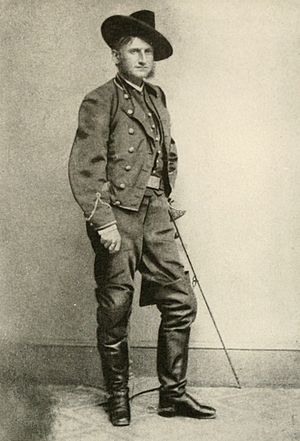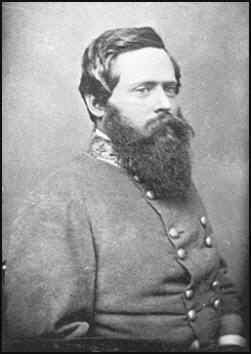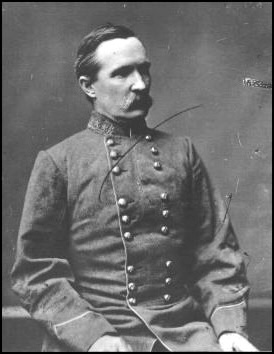Tuesday, October 29, 2013
Siege of Chattanooga - Battle of Wauhatchie Station
When Grant arrived in Chattanooga to take command of the army under siege by Bragg's Confederates, he was told of a plan that had been devised by the army's chief engineer William “Baldy” Smith, to get supplies into the town. He liked it, and ordered that it be put into execution. It was called the Cracker Line. The plan was for supplies to be brought to Kelley's Ferry on the Tennessee, then overland through Cummings Gap in Raccoon Mountain, cross the river again at Brown's Ferry, then brought across the river directly into the city.
To use this line however Bragg's men would have to be driven across Raccoon Mountain. Grant planned to have Hooker move under cover of darkness to meet up with two columns of troops from Thomas, one of which would silently float pass Lookout Mountain while the other would march overland as reinforcements. He ordered that it be put into execution early on the morning of October 27th. The men from Thomas were successful in passing Lookout Mountain without being sighted. They set up a Pontoon bridge and captured Brown's Ferry with little resistance, as few Confederate units had been stationed in the area. The next day Hooker arrived, and the Cracker line was secured right under Bragg's noose. It was put into operation, and know there was no trouble getting men or supplies into Chattanooga.
The Confederates were upset that the siege had been lifted, and immediately began trying to cut the Cracker Line. Longstreet decided to strike at Wauhatchie Station, where John Greary's division was in a weaker position than the rest of Hocker's men. Longstreet ordered a night attack to be made, and it went into effect early on the morning of October 29, 150 years ago today. The strike was scheduled for 10 pm, but the darkness delayed the march for two hours. Greary's men were surprised, and were driven back into a V shaped position anchored on the river. Two Union corps were sent to his aid, and the Confederates fell back in co fusion. The battle had been badly planned on both sides, and the confusion of a night attack destroyed the Confederate chances for victory.
Labels:
battle,
Braxton Bragg,
campaign,
Chattanooga,
Georgia,
James Longstreet,
Joseph Hooker,
Tennesse
Saturday, October 19, 2013
Buckland Races
After an uninspiring showing in the first few years of the war, in 1863 the Federal Army of the Potomac's cavalry did a better job in resisting J.E.B. Stuart's famed troopers. But 150 years ago today they would meet another embarrassing disaster. As part of the Bristoe Campaign, Robert Lee had advanced to Manassas Junction, but was falling back, shielded by Stuart's cavalry. The Union cavalry division of Judson Kilpatrick (or “Kilcavalry” as he was known by disaffected troopers) advanced towards Buckland.
The lead brigade of Feerals encountered gray troopers at Buckland Mills. Deploying for battle, they pushed the Confederates about a mile back down the road. But unbeknownst to them, they were doing exactly what Stuart wanted. He had ordered the column of Fitzhugh Lee to come up and strike the Federals on the flank. The Union units became separated in their rapid advanced.
The trap was sprung, and Lee surprised the Federal cavalry, attacking them from the flank. But some firm fighting by the Federal troopers prevented Lee from capturing a sizable portion of the Northerners. But panic spread through the Yankee column, and they were soon retreating at a gallop towards the main Union body, with Stuart's men hot on their heals. One Federal described it as a “deplorable spectacle of 7,000 cavalry dashing riderless, hatless, and panic stricken.” The flight was finally stopped when they reached the Union infantry. About 250 Union soldiers were captured, and the legend of the Buckland Races was born.
 |
| Kilpatrick |
 |
| Fitzhugh Lee |
Labels:
campaign,
cavalry,
J. E. B. Stuart,
Virginia
Monday, October 14, 2013
Battle of Bristoe Station
 |
| Bristoe Station Campaign |
 |
| Harry Heth |
 |
| Bristoe Station Battlefield. Source. |
Labels:
A. P. Hill,
battle,
campaign,
Harry Heth,
Robert E. Lee,
Virginia
Bristoe Campaign
No great battles had been fought in the eastern theater of the Civil War after Lee's defeat at the Battle of Gettysburg. Meade had failed to aggressively pursue the Confederates, and he received much criticism for this from Washington. Back in Virginia, both army commanders began trying to maneuver the other into a position where they could fight to advance. Lee was down to two corps after the detachment of Longstreet to fight with Bragg at Chicakamuga, Meade pushed his troops forward, preparing to cross the Rapidan and strike the Confederate positions, but he lost two corps, sent to aid in defending Chattanooga.
When Lee heard of this movement, he saw it as a great opportunity to strike. He began moving around Meade's right flank with his troops. Meade saw that the position was disadvantageous to the Federals, so he decided to fall back, even though he had the superior numbers. He began moving north 150 years ago today. The maneuvering and fighting in Virginia would continue into November, both sides looking for an opportunity to strike.
Labels:
campaign,
George Meade,
Robert E. Lee,
Virginia
Thursday, October 10, 2013
Siege of Chattanooga
After defeating Rosecrans's Union army at the Battle of Chickamauga, Bragg's Confederates received intelligence that their foes were in full retreat, but they did not mount an aggressive pursuit. Bragg did not want to leave the railroad, which was serving as his supply line. The cavalry under Nathan Bedford Forest moved to within three miles of Chattanooga, where the Federals had positioned themselves. The placed could have been easily captured, but Bragg would not move. The fruits of victory were lost by the Confederate failure to advance. Their victory was rendered almost useless.
By the time they arrived on the hills surrounding Chattanooga, the Federals were prepared for a long defense. By September 23rd the Confederates occupied Lookout Mountain and Missionary Ridge, and a siege of Chattanooga began. James Longstreet, commanding a corps from Lee temporarily detached to help Bragg, wished to attempt a flanking movement, but Bragg refused. He preferred just to wait and starve out Rosecrans, as he had received word that the Yankees only had six days provisions. He extended the Confederate lines to Raccoon Mountain, and placed artillery to cover the roads that ran along the edge of the Tennessee River. Thus blocking the easiest access to the town, he forced the Federals to carry what supplies they could bring across sixty miles of muddy roads.
When Lincoln got news of Rosecrans's disaster, he decided to reinforce him without delay. Hooker's Corps from Virginia was rushed west by railroad, and Ulysees S. Grant, who had been given command of all the forces from the Allegheny Mountains to the Mississippi, was ordered to march to Chattanooga with 20,000 men. Although when the siege began Bragg had more men, his decision not to assault meant that after a few days Hooker arrived. With these new men the Union garrison outnumbered the Confederate besiegers.
The Union high command was not impressed with Rosecrans's performance after his defeat at Chickamauga. Charles Dana, assistant secretary of war reported on Rosecrans
By the time they arrived on the hills surrounding Chattanooga, the Federals were prepared for a long defense. By September 23rd the Confederates occupied Lookout Mountain and Missionary Ridge, and a siege of Chattanooga began. James Longstreet, commanding a corps from Lee temporarily detached to help Bragg, wished to attempt a flanking movement, but Bragg refused. He preferred just to wait and starve out Rosecrans, as he had received word that the Yankees only had six days provisions. He extended the Confederate lines to Raccoon Mountain, and placed artillery to cover the roads that ran along the edge of the Tennessee River. Thus blocking the easiest access to the town, he forced the Federals to carry what supplies they could bring across sixty miles of muddy roads.
 |
| Rosecrans |
 |
| Chattanooga from Lookout Mountain |
I have never seen a public man possessing talent with less administrative power, less clearness and steadiness in difficulty, and greater practical incapacity than General Rosecrans. ... Under the present circumstances I consider this army to be very unsafe in his hands.Grant eventually decided to replace Rosecrans with George Thomas, the new Federal hero who had held the field at Chickamauga after Rosecrans and most of the army had fled.





